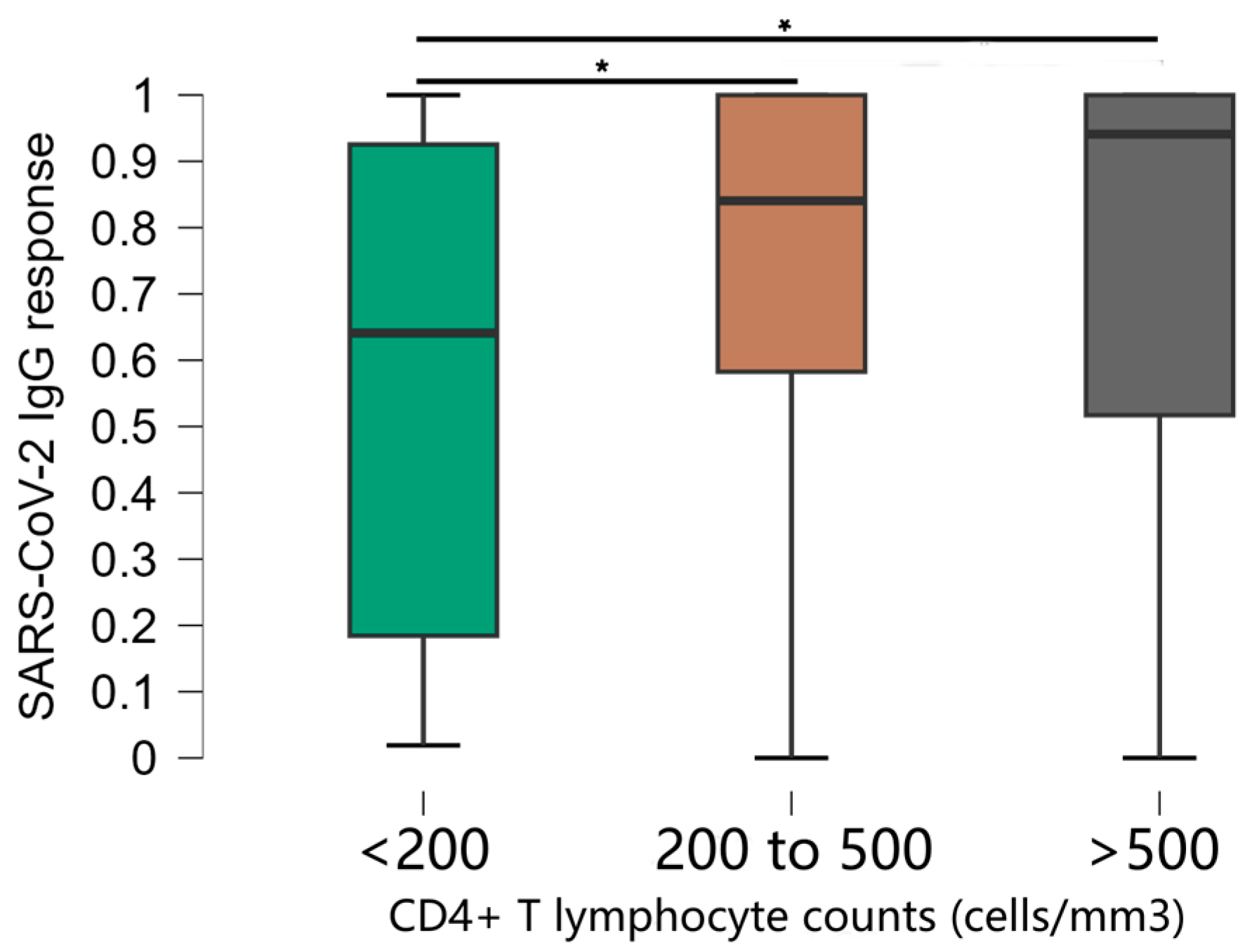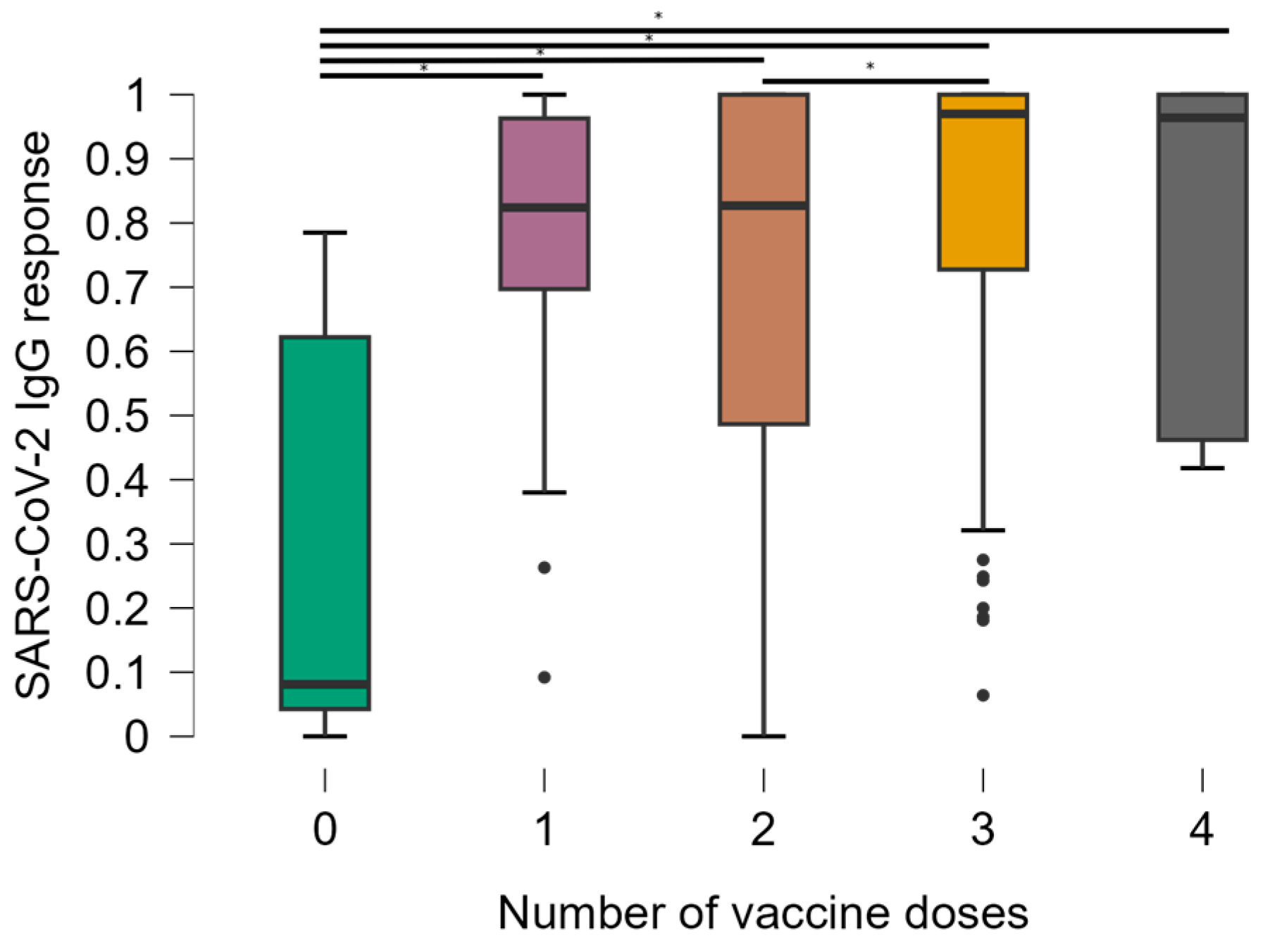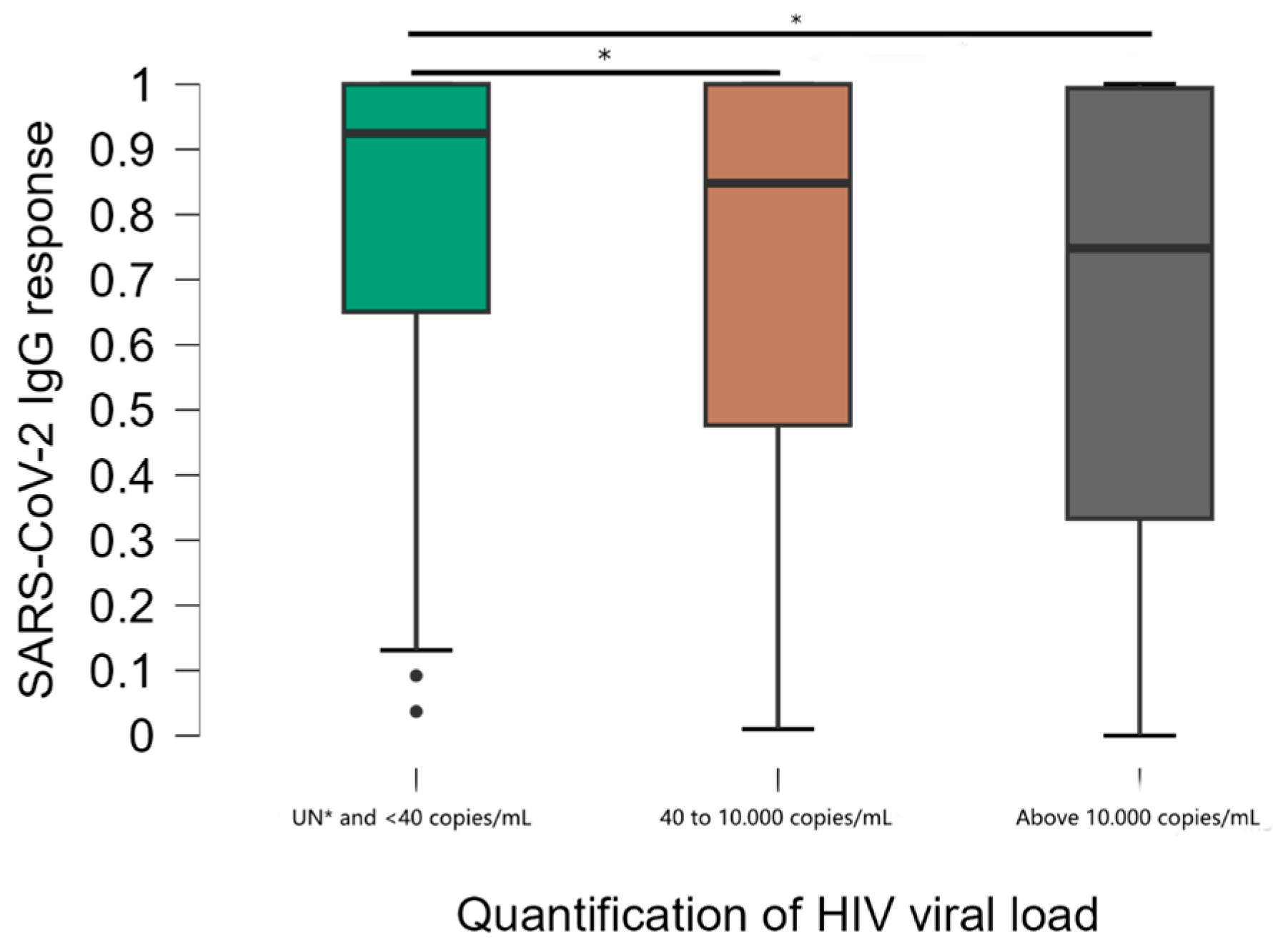Efficacy of COVID-19 Vaccination in People Living with HIV/AIDS in a Northern Brazil: Cross-Sectional Study
Abstract
1. Introduction
2. Materials and Methods
2.1. Study Design, Ethics and Study Area
2.2. Inclusion and Exclusion Criteria, Collection, Processing, and Storage of Samples
2.3. Detection of IgG Anti-SARS-CoV-2
2.4. Quantification of CD4+/CD8+ T lymphocytes and HIV-1 Plasma Viral Load
2.5. Statistical Analysis
3. Results
3.1. Epidemiological Data
3.2. Anti-SARS-CoV-2 IgG Antibodies
4. Discussion
5. Conclusions
Author Contributions
Funding
Institutional Review Board Statement
Informed Consent Statement
Data Availability Statement
Acknowledgments
Conflicts of Interest
References
- Grant, J.K.; Vincent, L.; Ebner, B.; Hurwitz, B.E.; Alcaide, M.L.; Martinez, C. Early Insights into COVID-19 in Persons Living with HIV and Cardiovascular Manifestations. J. AIDS HIV Treat 2020, 2, 68–74. [Google Scholar] [PubMed]
- Zhu, F.; Cao, Y.; Xu, S.; Zhou, M. Co-infection of SARS-CoV-2 and HIV in a patient in Wuhan city, China. J. Med. Virol. 2020, 92, 529–530. [Google Scholar] [CrossRef]
- Monforte, A.D.; Bonnet, F.; Bucher, H.; Pourcher, V.; Pantazis, N.; Pelchen-Matthews, A.; Touloumi, G.; Wolf, E. What do the changing patterns of comorbidity burden in people living with HIV mean for long-term management? Perspectives from European HIV cohorts. HIV Med. 2020, 21 (Suppl. S2), 3–16. [Google Scholar] [CrossRef] [PubMed]
- Braunstein, S.L.; Lazar, R.; Wahnich, A.; Daskalakis, D.C.; Blackstock, O.J. Coronavirus disease 2019 (COVID-19) infection among people with human immunodeficiency virus in New York City: A population-level analysis of linked surveillance data. Clin. Infect. Dis. 2021, 72, e1021–e1029. [Google Scholar] [CrossRef]
- Tesoriero, J.M.; Swain, C.-A.E.; Pierce, J.L.; Zamboni, L.; Wu, M.; Holtgrave, D.R.; Gonzalez, C.J.; Udo, T.; Morne, J.E.; Hart-Malloy, R.; et al. COVID-19 outcomes among persons living with or without diagnosed HIV infection in New York State. JAMA 2021, 4, e2037069. [Google Scholar] [CrossRef]
- Sachdev, D.; Mara, E.; Hsu, L.; Scheer, S.; Rutherford, G.; Enanoria, W.; Gandhi, M. COVID-19 susceptibility and outcomes among people living with HIV in San Francisco. JAIDS J. Acquir. Immune Defic. Syndr. 2021, 86, 19–21. [Google Scholar] [CrossRef] [PubMed]
- Fung, M.; Babik, J.M. COVID-19 in immunocompromised hosts: What we know so far. Clin. Infect. Dis. 2021, 72, 340–350. [Google Scholar] [CrossRef] [PubMed]
- Bergman, P.; Blennow, O.; Hansson, L.; Mielke, S.; Nowak, P.; Chen, P.; Söderdahl, G.; Österborg, A.; Smith, C.I.E.; Wullimann, D.; et al. Safety and efficacy of the mRNA BNT162b2 vaccine against SARS-CoV-2 in five groups of immunocompromised patients and healthy controls in a prospective open-label clinical trial. EBioMed 2021, 74, 103705. [Google Scholar] [CrossRef]
- Strengert, M.; Becker, M.; Ramos, G.M.; Dulovic, A.; Gruber, J.; Juengling, J.; Lurken, K.; Beigele, A.; Wrengere, E.; Lonnemann, G.; et al. Cellular and humoral immunegenicity of a SARS-CoV-2 mRNA vaccine in patients on haemodialysis. EBioMed 2021, 70, 103524. [Google Scholar] [CrossRef]
- De Placido, P.; Pietroluongo, E.; De Angelis, C.; Tafuro, M.; Barraco, C.; Giannatiempo, R.; Buonaiuto, R.; Schettini, F.; Iervolino, A.; Vozzella, E.A.; et al. Safety and immunogenicity of the COVID-19 vaccine BNT162b2 for patients with breast and gynecological cancer on active anticancer therapy: Results of a prospective observational study. Front. Oncol. 2022, 19, 951026. [Google Scholar] [CrossRef]
- Bertrand, D.; Hamzaoui, M.; Lemée, V.; Lamulle, J.; Hanoy, M.; Laurent, C.; Lebourg, L.; Etienne, I.; Lemoine, M.; Le Roy, F.; et al. Antibody and T cell response to SARS-CoV-2 messenger RNA BNT162b2 vaccine in kidney transplant recipients and hemodialysis patients. J. Am. Soc. Nephrol. 2021, 32, 2147–2152. [Google Scholar] [CrossRef] [PubMed]
- Kamar, N.; Abravanel, F.; Marion, O.; Couat, C.; Izopet, J.; Del Bello, A. Three doses of an mRNA Covid-19 vaccine in solid-organ transplant recipients. N. Engl. J. Med. 2021, 385, 661–662. [Google Scholar] [CrossRef] [PubMed]
- Boyarsky, B.J.; Werbel, W.A.; Avery, R.K.; Tobian, A.A.; Massie, A.B.; Segev, D.L.; Garonzik-Wang, J.M. Antibody response to 2-dose SARS-CoV-2 mRNA vaccine series in solid organ transplant recipients. JAMA 2021, 325, 2204–2206. [Google Scholar] [CrossRef] [PubMed]
- Marion, O.; Del Bello, A.; Abravanel, F.; Couat, C.; Faguer, S.; Esposito, L.; Hebral, A.L.; Izopet, J.; Kamar, N. Safety and immunogenicity of anti–SARS-CoV-2 messenger RNA vaccines in recipients of solid organ transplants. Ann. Intern. Med. 2021, 174, 1336–1338. [Google Scholar] [CrossRef]
- Georgery, H.; Devresse, A.; Yombi, J.C.; Belkhir, L.; De Greef, J.; Darius, T.; Buemi, A.; Scohy, A.; Kabamba, B.; Goffin, E.; et al. Very low immunization rate in kidney transplant recipients after one dose of the BNT162b2 vaccine: Beware not to lower the guard! Transplantation 2021, 105, e148–e149. [Google Scholar] [CrossRef]
- Brazilian Ministry of Health (BMH). Coronavirus Disease 2019 (COVID-19) Case Dashboard in Brazil. Available online: https://covid.saude.gov.br (accessed on 16 April 2024).
- Rocha, S.Q.; Avelino-Silva, V.I.; Tancredi, M.V.; Jamal, L.F.; Ferreira, P.R.A.; Tayra, A.; Carvalhanas, T.; Domingues, C.S.B.; Souza, R.A.; Gianna, M.C.; et al. COVID-19 and HIV/AIDS in a cohort study in Sao Paulo, Brazil: Outcomes and disparities by race and schooling. AIDS Care 2022, 34, 832–838. [Google Scholar] [CrossRef]
- Pará State Secretariat of Public Health (SESPA). Coronavirus in Pará State. Available online: https://www.covid-19.pa.gov.br/#/ (accessed on 10 March 2024).
- Naeem, W.; Zeb, H.; Rashid, M.I. Laboratory biosafety measures of SARS-CoV-2 at containment level 2 with particular reference to its more infective variants. Biosaf. Health 2022, 4, 11–14. [Google Scholar] [CrossRef]
- Brazilian Ministry of Health (BMH). Clinical Protocol and Therapeutic Guidelines for Managing HIV Infection in Adults. Available online: https://www.gov.br/aids/pt-br/central-de-conteudo/pcdts/2013/hiv-aids/pcdt_manejo_adulto_12_2018_web.pdf/view (accessed on 22 June 2024).
- Beck, C.R.; McKenzie, B.C.; Hashim, A.B.; Harris, R.C.; Zanuzdana, A.; Agboado, G.; Orton, E.; Béchard-Evans, L.; Morgan, G.; Stevenson, C.; et al. Influenza vaccination for immunocompromised patients: Systematic review and meta-analysis from a public health policy perspective. PLoS ONE 2011, 6, e29249. [Google Scholar] [CrossRef]
- George, V.K.; Pallikkuth, S.; Parmigiani, A.; Alcaide, M.; Fischl, M.; Arheart, K.L.; Pahwa, S. HIV infection worsens age-associated defects in antibody responses to influenza vaccine. J. Infec. Dis. 2015, 211, 1959–1968. [Google Scholar] [CrossRef]
- Polack, F.P.; Thomas, S.J.; Kitchin, N.; Absalon, J.; Gurtman, A.; Lockhart, S.; Perez, J.L.; Pérez Marc, G.; Moreira, E.D.; Zerbini, C.; et al. Safety and Efficacy of the BNT162b2 mRNA COVID-19 Vaccine. N. Engl. J. Med. 2020, 383, 2603–2615. [Google Scholar] [CrossRef]
- Nault, L.; Marchitto, L.; Goyette, G.; Tremblay-Sher, D.; Fortin, C.; Martel-Laferrière, V.; Trottier, B.; Richard, J.; Durand, M.; Kaufmann, D.; et al. COVID-19 vaccine immunogenicity in people living with HIV-1. Vaccine 2022, 40, 3633–3637. [Google Scholar] [CrossRef] [PubMed]
- Pattanapanyasat, K.; Phuang-Ngern, Y.; Sukapirom, K.; Lerdwana, S.; Thepthai, C.; Tassaneetrithep, B. Comparison of 5 flow cytometric immunophenotyping systems for absolute CD4+ T-lymphocyte counts in HIV-1-infected patients living in resource-limited settings. J. Acquir. Immune Defic. Syndr. 2008, 49, 339–347. [Google Scholar] [CrossRef]
- Adedokun, G.; Sidhu, G.; Alipanah, M.; Wang, G.P.; Fan, Z.H. A handheld HIV detection platform using paper-based sample preparation and real-time isothermal amplification. Microsyst. Nanoeng. 2024, 10, 181. [Google Scholar] [CrossRef]
- Ruddy, J.A.; Boyarsky, B.J.; Bailey, J.R.; Karaba, A.H.; Garonzik-Wang, J.M.; Segev, D.L.; Durang, C.M.; Werbel, W.A. Safety and antibody response to two-dose SARS-CoV-2 messenger RNA vaccination in persons with HIV. AIDS 2021, 35, 2399–2401. [Google Scholar] [CrossRef] [PubMed]
- Schmidt, K.G.; Harrer, E.G.; Tascilar, K.; Kübel, S.; El Kenz, B.; Hartmann, F.; Simon, D.; Schett, G.; Nganou-Makamdop, K.; Harrer, T. Characterization of serum and mucosal SARS-CoV-2-antibodies in HIV-1-infected subjects after BNT162b2 mRNA vaccination or SARS-CoV-2 infection. Viruses 2022, 14, 651. [Google Scholar] [CrossRef] [PubMed]
- Da Dandachi, D.; Geiger, G.; Montgomery, M.W.; Karmen-Tuohy, S.; Golzy, M.; Antar, A.A.; Llibre, J.M.; Camazine, M.; Santiago, D.-D.; Carlucci, P.M.; et al. Characteristics, comorbidities, and outcomes in a multicenter registry of patients with human immunodeficiency virus and coronavirus disease 2019. Clin. Infect. Dis. 2021, 73, e1964–e1972. [Google Scholar] [CrossRef]
- Hoffmann, C.; Casado, J.L.; Härter, G.; Vizcarra, P.; Moreno, A.; Cattaneo, D.; Meraviglia, P.; Spinner, C.D.; Schabaz, F.; Grunwald, S.; et al. Immune deficiency is a risk factor for severe COVID-19 in people living with HIV. HIV Med. 2021, 22, 372–378. [Google Scholar] [CrossRef]
- Touizer, E.; Alrubayyi, A.; Rees-Spear, C.; Fisher-Pearson, N.; Griffith, S.A.; Muir, L.; Pellegrino, P.; Waters, L.; Burns, F.; Kinloch, S.; et al. Failure to seroconvert after two doses of BNT162b2 SARS-CoV-2 vaccine in a patient with uncontrolled HIV. Lancet HIV 2021, 8, e317–e318. [Google Scholar] [CrossRef]
- Lambarey, H.; Blumenthal, M.J.; Chetram, A.; Joyimbana, W.; Jennings, L.; Tincho, M.B.; Burgers, W.A.; Orrell, C.; Schäfer, G. SARS-CoV-2 Infection Is Associated with Uncontrolled HIV Viral Load in Non-Hospitalized HIV-Infected Patients from Gugulethu, South Africa. Viruses 2022, 14, 1222. [Google Scholar] [CrossRef]
- Lee, K.W.; Yap, S.F.; Ngeow, Y.F.; Lye, M.S. COVID-19 in people living with HIV: A systematic review and meta-analysis. Int. J. Environ. Res. Public Health 2021, 18, 3554. [Google Scholar] [CrossRef]
- Zhou, Q.; Liu, Y.; Zeng, F.; Meng, Y.; Liu, H.; Deng, G. Correlation between CD4 T-Cell Counts and Seroconversion among COVID-19 Vaccinated Patients with HIV: A Meta-Analysis. Vaccines 2023, 11, 789. [Google Scholar] [CrossRef] [PubMed]
- Brazilian Ministry of Health (BMH). Extraordinary Secretariat for Combating COVID-19, Secovid. In the COVID-19 Vaccination Operationalization Plan. Available online: https://sbim.org.br/images/files/notas-tecnicas/plano-nacional-de-vacinacao-covid-19-11edicao.pdf (accessed on 16 February 2025).
- Oliveira, C.F.; Neto, W.F.F.; Silva, C.P.D.; Ribeiro, A.C.S.; Martins, L.C.; Sousa, A.W.; Freitas, M.N.O.; Chiang, J.O.; Silva, F.A.; Santos, E.B.D.; et al. Absence of Anti-RBD Antibodies in SARS-CoV-2 Infected or Naive Individuals Prior to Vaccination with CoronaVac Leads to Short Protection of Only Four Months Duration. Vaccines 2022, 10, 690. [Google Scholar] [CrossRef]
- Thomas, J.; Rajmohan, P.; Jose, P.; Kannan, R.; Jose, R.; Uttumadathil Gopinathan, U.; Raphael, L.; Baiju, N.M.; Krishna, S.; Attokaran, T.; et al. Real-World Effectiveness of COVID-19 Vaccine and Identification of SARS-CoV-2 Variants among People Living with HIV on Highly Active Antiretroviral Therapy in Central Kerala of India—An Ambi-Directional Cohort Study. Viruses 2023, 15, 2187. [Google Scholar] [CrossRef] [PubMed]
- Madhi, S.A.; Koen, A.L.; Izu, A.; Fairlie, L.; Cutland, C.L.; Baillie, V.; Padayachee, S.D.; Dheda, K.; Barnabas, S.L.; Bhorat, Q.E.; et al. Safety and immunogenicity of the ChAdOx1 nCoV-19 (AZD1222) vaccine against SARS-CoV-2 in people living with and without HIV in South Africa: An interim analysis of a randomised, double-blind, placebo-controlled, phase 1B/2A trial. Lancet HIV 2021, 8, e568–e580. [Google Scholar] [CrossRef] [PubMed]
- Ao, L.; Lu, T.; Cao, Y.; Chen, Z.; Wang, Y.S.; Li, Z.; Ren, X.; Xu, P.; Peng, M.; Chen, M.; et al. Safety and immunogenicity of inactivated SARS-CoV-2 vaccines in people living with HIV. Emerg. Microbes Infect. 2022, 11, 1126–1134. [Google Scholar] [CrossRef]
- Liu, Z.; Pang, C.; Deng, Y.; Guo, C.; Li, J.; Li, Y.; Xin, R.; Li, X.; Xu, C.; Huang, C.; et al. Humoral immune response following the inactivated quadrivalent influenza vaccination among HIV-infected and HIV-uninfected adults. Vaccine 2023, 41, 4978–4985. [Google Scholar] [CrossRef]
- Crum-Cianflone, N.F.; Wallace, M.R. Vaccination in HIV-infected adults. AIDS Patient Care STDS 2014, 28, 397–410. [Google Scholar] [CrossRef]
- Moran, J.A.; Turner, S.R.; Marsden, M.D. Contribution of Sex Differences to HIV Immunology, Pathogenesis, and Cure Approaches. Front. Immunol. 2022, 25, 905773. [Google Scholar] [CrossRef]
- Murray, S.M.; Ansari, A.M.; Frater, J.; Klenerman, P.; Dunachie, S.; Barnes, E.; Ogbe, A. The impact of pre-existing cross-reactive immunity on SARS-CoV-2 infection and vaccine responses. Nat. Rev. Immunol. 2023, 23, 304–316. [Google Scholar] [CrossRef]



| Epidemiological Characteristics | n = 510 (%) | p Value | Standard Deviations |
|---|---|---|---|
| Sex | 0.70 | 0.458 | |
| Male | 357 (70%) | ||
| Female | 153 (30%) | ||
| Age Range (Years) | 0.39 | 0.489 | |
| <25 | 68 (13.3%) | ||
| 25–50 | 367 (72%) | ||
| >50 | 75 (14.7%) | ||
| Ethnicity * | 0.52 | 0.499 | |
| Mixed | 321 (63%) | ||
| Black | 92 (18%) | ||
| White | 82 (16%) | ||
| Did not respond | 15 (3%) | ||
| Marital Status | 0.67 | 0.471 | |
| Single | 364 (71.3%) | ||
| Married | 112 (22%) | ||
| Divorced/Widowed | 29 (5.7%) | ||
| Did not respond | 5 (1%) | ||
| Educational level | 0.50 | 0.500 | |
| Elementary school | 106 (21.6%) | ||
| High school | 296 (58%) | ||
| College degree | 104 (20.4%) | ||
| Family income/monthly (US$ 234.81) ** | 0.30 | 0.465 | |
| Up to 1 salary | 257 (50.4%) | ||
| 2 to 3 salaries | 183 (35.6%) | ||
| >4 salaries | 50 (10%) | ||
| Did not respond | 20 (4%) | ||
| HIV diagnosed period | 0.33 | 0.473 | |
| <5 years | 278 (54.6%) | ||
| 5 to 10 years | 130 (25.4%) | ||
| >10 years | 54 (10.6%) | ||
| Did not respond | 48 (9.4%) | ||
| Comorbidities | 0.15 | 0.362 | |
| Yes | 77 (15%) | ||
| No | 433 (85%) | ||
| COVID-19 vaccination status | 0.974 | 0.164 | |
| Yes | 497 (97.4%) | ||
| No | 13 (2.6%) | ||
| COVID-19 vaccines of doses | 0.25 | 0.436 | |
| 1 dose | 18 (3.6%) | ||
| 2 doses | 271 (54.5%) | ||
| 3 doses | 191 (38.4%) | ||
| 4 doses | 17 (3.5%) | ||
| CD4+ T lymphocyte count (cells/mm3) | 0.33 | 0.469 | |
| <200 | 43 (9.5%) | ||
| ≥200 to 500 | 168 (37.2%) | ||
| >500 | 241 (53.3%) | ||
| Viral load quantification (copies/mL) | 0.33 | 0.458 | |
| Not detected (<40 copies/mL) | 350 (69%) | ||
| ≥200 to 500 | 88 (17.4%) | ||
| >500 | 69 (13.6%) |
| Elisa Results (n = 510) | n = 510 (%) | Vaccinated n = 497 (%) | Not Vaccinated n = 13 (%) |
|---|---|---|---|
| Non-reactive | 19 (3.72) | 13 (2.61) | 6 (46.1) |
| Undetermined | 10 (2.15) | 9 (1.81) | 1 (7.69) |
| Reagent | 481 (94.31) | 475 (95.57) | 6 (46.1) |
| Number of Doses | <200 | ≥200 | p Value * |
|---|---|---|---|
| n (Med; IIQ *) | n (Med; IIQ *) | ||
| 1 Dose | 1 (0.09; -) | 15 (0.84; 0.26) | - |
| 2 Doses | 28 (0.40; 0.64) | 210 (0.86; 0.48) | 0.002 |
| 3 Doses | 11 (0.89; 0.20) | 155 (0.97; 0.27) | 0.334 |
| 4 Doses | 0 (-) | 11 (1; 0.55) | - |
Disclaimer/Publisher’s Note: The statements, opinions and data contained in all publications are solely those of the individual author(s) and contributor(s) and not of MDPI and/or the editor(s). MDPI and/or the editor(s) disclaim responsibility for any injury to people or property resulting from any ideas, methods, instructions or products referred to in the content. |
© 2025 by the authors. Licensee MDPI, Basel, Switzerland. This article is an open access article distributed under the terms and conditions of the Creative Commons Attribution (CC BY) license (https://creativecommons.org/licenses/by/4.0/).
Share and Cite
Santos, C.d.J.S.e.; Fonseca, R.R.d.S.; Lima, S.S.; Carvalho, T.M.d.S.; das Mercês, L.F.; Avelino, M.E.d.S.; de Araújo, D.O.; Freitas, F.B.; Brasil-Costa, I.; Oliveira-Filho, A.B.; et al. Efficacy of COVID-19 Vaccination in People Living with HIV/AIDS in a Northern Brazil: Cross-Sectional Study. Vaccines 2025, 13, 283. https://doi.org/10.3390/vaccines13030283
Santos CdJSe, Fonseca RRdS, Lima SS, Carvalho TMdS, das Mercês LF, Avelino MEdS, de Araújo DO, Freitas FB, Brasil-Costa I, Oliveira-Filho AB, et al. Efficacy of COVID-19 Vaccination in People Living with HIV/AIDS in a Northern Brazil: Cross-Sectional Study. Vaccines. 2025; 13(3):283. https://doi.org/10.3390/vaccines13030283
Chicago/Turabian StyleSantos, Carolinne de Jesus Santos e, Ricardo Roberto de Souza Fonseca, Sandra Souza Lima, Thais Mayara da Silva Carvalho, Letícia França das Mercês, Maria Eduarda de Sousa Avelino, Diogo Oliveira de Araújo, Felipe Bonfim Freitas, Igor Brasil-Costa, Aldemir Branco Oliveira-Filho, and et al. 2025. "Efficacy of COVID-19 Vaccination in People Living with HIV/AIDS in a Northern Brazil: Cross-Sectional Study" Vaccines 13, no. 3: 283. https://doi.org/10.3390/vaccines13030283
APA StyleSantos, C. d. J. S. e., Fonseca, R. R. d. S., Lima, S. S., Carvalho, T. M. d. S., das Mercês, L. F., Avelino, M. E. d. S., de Araújo, D. O., Freitas, F. B., Brasil-Costa, I., Oliveira-Filho, A. B., Rosário Vallinoto, A. C., & Machado, L. F. A. (2025). Efficacy of COVID-19 Vaccination in People Living with HIV/AIDS in a Northern Brazil: Cross-Sectional Study. Vaccines, 13(3), 283. https://doi.org/10.3390/vaccines13030283







